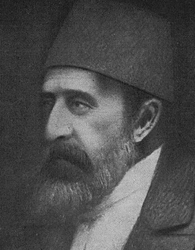Sultan Abdulhamid II, who ruled the Ottoman Empire for more than 30 years, earned a reputation both as an oppressive leader and a champion of Turkish industry, education and culture.
Sultan Abdulhamid’s Early Days
Abdülhamid II (or Abdul-Hamid II) was born in Constantinople, now Istanbul, on September 21, 1842, the son of Sultan Abdulmecid I, who ruled from 1839 to 1861. Abdülhamid, who lost his mother at a young age, was educated in many topics, including playing the piano. After he married, Abdülhamid devoted his time to his family, which would eventually include eight wives and 16 children. At age 33, he succeeded his brother Murad V, who was considered to be mentally unstable.
In 1876, the year he took power, Abdülhamid issued the Ottoman Empire’s first constitution under the guidance of the grand vizier Midhat Pasha, who had helped to reform the government and oust Murad V. But shortly thereafter, Abdülhamid removed Midhat Pasha from his position and exiled him. The Encyclopedia of World Biography writes that “[f]rom this time until 1908, the Sultan ignored the constitution.”
Sources in this Story
- TheOttomans.org: The Sultans: Abdulhamid II
- Bookrags (The Encyclopedia of World Biography): Abdul-Hamid II
- Encyclopedia Britannica: Sultan Abdulhamid II
- The Museum of Architecture (Turkey): A Sultan’s Title Deed and two Woman’s Building Documents | Sultan Abdulhamid II’s Title Deed
- The Constitutional Rights Foundation: “Forgotten Genocide”: The Destruction of the Armenians During World War I
- The New York Times: Sultan Beaten. Capital Falls. 6,000 Slain.
Abdulhamid’s Notable Accomplishments
Abdülhamid ruled as an autocrat, but he spearheaded lasting achievements for Turkey’s education system, creating schools and institutions that are still in existence today. According to the Encyclopedia Britannica, “18 professional schools were established; Darülfünun, later known as the University of Istanbul, was founded in 1900, and a network of secondary, primary, and military schools was extended throughout the empire. In addition, the Ministry of Justice was reorganized, and railway and telegraph systems were developed.” According to the historical site The Ottomans, Abdülhamid “lived the life of a common person,” spending his own money to fund a military campaign in Greece, as well as the construction of a hospital and poorhouse.
Abdülhamid II was the first Ottoman sultan to have title deeds to his own property, according to Turkey’s online Museum of Architecture, which hosts an image of a title deed belonging to the sultan, and adds that he owned property in Mosul, Kirkuk, Palestine, Eastern Anatolia, Cukurova, Balıkesir and Balkans, “some of which went by the name of ‘imperial farms.’” There were allegedly many more title deeds under the sultan’s name, and these were said to be the sultan’s attempts to retain control of land in a shrinking Ottoman Empire.
The Rest of the Story
Abdülhamid II has justifiably not been treated kindly by the history books, as positive efforts to reassert his empire’s preeminence were undermined by oppressive treatment of ethnic groups such as the Christian Armenians. Encouraging Muslim Kurds to inhabit Armenian areas, and encouraging violence toward the Armenians, whom he believed to be rebelling against him, Abdülhamid oversaw the deaths of about 200,000 Armenians over two years. As the Constitutional Rights Foundation explains, “Apparently, the sultan’s purpose was not to exterminate the Christian Armenian minority, but to permanently end its demands for equal rights. Even so, many historians have noted that the massacres of 1894–96 provided a precedent for the genocide that took place 20 years later” during World War I.
The reign of Abdülhamid II ended on April 24, 1909, when the Constitutionalists, also known as the Young Turks, stormed the palace. Though Abdülhamid initially remained inside, a New York Times correspondent wrote that “there is not even a sentinel at the gate” of the palace. “The eunuchs and servants of the palace are stealing all they can. The doors stand wide open. Meanwhile, the people cheer the liberators vociferously, offer them food and drink, and embrace them in the street.”
Following the invasion of the palace, Abdülhamid II was exiled to Salonika, Greece, where he died nine years later. His brother Mehmed V succeeded him to the throne.
This article was originally written by Liz Colville; it was updated September 13, 2017.











